This is an excerpt from a teaching held on the United Trugram Buddhist Fellowship website of Trungram Gyaltrul Rinpoche.
Brief History of the Kagyu Lineage
There are many types of doctrines. Some relate to us, like what has happened or what a particular thing is, and others deal with our hearts or our inner-self, and relate to us what should be done and how to go about it. What I shall speak about today is the history of our lineage. In doing so, relating what had happened over the course of the history of the lineage and how to practice the teachings and cultivate the Dharma.
Of course, we can only give a brief introduction on the history of our lineage in the course of this talk. If one seeks to have a better understanding of the Kagyu lineage, the biography of the various gurus should be consulted. It is from their experiences that we can uncover insights, which will enable us to understand the Buddhist Dharma and how to cultivate it. This is something that we should all note.
Brief History of Buddhism in India
Our lineage can trace its origins to the time of Shakyamuni Buddha centuries ago. Shakyamuni Buddha was born in Lumbini or what is now Nepal. It is generally accepted that Shakyamuni Buddha was born in 2545, based on the Buddhist calendar. Despite this, the genesis of Buddhism started when Shakyamuni Buddha was 36 years old, when he gained enlightenment under the Bodhi tree at Bodhgaya (present day India). The triple jewels or gems (Buddha, Dharma and Sangha) appeared when Buddha Shakyamuni turned the wheel of the Dharma for the first rime, when he taught the Dharma to the first 5 Bhiksus. At that time, Prince Siddharta had achieved enlightenment and in doing so, became Shakyamuni Buddha. The 5 Bhiksus became the “Sangha”, part of the 3 precepts that we take refuge in. The discourse by Shakyamuni Buddha to these 5 Bhiksus became what we now know as the Dharma.
Therefore, Buddhism has existed for around 2600 years and will continue to exist for a cycle of Kalpa totaling 5000 years. In the fourth Kalpa or Samvartta-Kalpa, Buddhism will start to decline whereby followers of Buddhism will decline in numbers. By the year 5000 in the Buddhist calendar, Buddhist Dharma, the doctrines or teachings of Shakyamuni Buddha will vanish totally from our realm. It is said that a total of 1,002 Buddhas or enlightened ones will be born in our realm. Shakyamuni Buddha is the Fourth.
When Shakyamuni Buddha entered Mahaparinirvana, he entrusted his doctrines and teachings to his best disciples. From thereon, it was handed down over a succession of eight generations. This is the prevailing notion, accepted even by the Shravakayana tradition. Between the 5th and the 8th generation, Buddhist disciples started including annotations to the doctrines and teachings. This marked the beginning of the Shastras.
According to the Mahayana tradition, the succession does not end over a period of 8 generations but rather over a period of 25 generations. Longer than what is held by the Hinayana tradition.
During the time of Shakyamuni Buddha, sutras did not exist. All the teachings of Shakyamuni Buddha were committed to memory by his arhat disciples. When Shakyamuni Buddha entered Mahaparinirvana, the arhats convened and committed all they had remembered, in writing over a succession of three meetings and assembled the teachings of Shakyamuni Buddha into what we now know as the sutras for the benefit of all beings.
Esoteric Vajrayana teachings only became widely practiced after the time of the Indian guru, Saraha. Despite this, Shakyamuni Buddha taught the esoteric or tantric teachings not only to humans but to deities and nagas as well.
Brief History of the Kagyu School: Its origin in India
The Kagyu School traces its origins to the Indian guru, Tilopa or even further to Shakyamuni Buddha when he taught the tantric teachings to Vajrahara who then handed it down to other Bodhisattvas, who subsequently handed them down to Nagarjuna who then taught Tilopa. Guru Tilopa can also trace his lineage to the adepts or Mahasiddhas Nagarjuna, Dombiba, Luipa and Sukhasiddhi. Each of these adepts represents the 4 cardinal points of the Indian continent.
For example, Nagarjuna represents the Southern Indian tradition or lineage, Dompiba represents the Western Indian tradition or lineage, Luipa represents the Northern tradition and Sukhasiddhi represents the Eastern Indian tradition. From these gurus, Tilopa was initiated into the major strands of vajra teachings of the day. In particular, he receives teachings on purification of chakra and subtle body, known by its Tibetan name of tumo, the illusory body, and radiant light teachings, and the dream yoga. Therefore, what we now know as the “Six Yogas” is the essence from these four traditions.
Tilopa once said, “My guru is none other than Sambhogakaya.” The dzogchen teachings from Sambhogakaya and Vajrayogini became known as the “Oral Transmissions”. After being initiated and taught various tantric practices, and ultimately perfection, both his knees will be locked and he would be unable to leave his place of meditation. Upon attaining enlightenment, Tilopa sang a vajra song and the lyrics tell that, 12,000 persons in India at that time benefited as a result of Tilopa having attained perfection in his practice.
During his lifetime, Tilopa was a fisherman. Nonetheless, he attained perfection. He handed on his tradition or lineage onto Naropa. Naropa was a prince who took the tonsure and became a monk. He was also one of the dharmapala or gatekeepers of the Eastern Gate of the Nalanda Buddhist University. When Naropa was seeking to be initiated into the lineage of Tilopa, he had to undergo 12 arduous tasks before he attained the same level of mastery and perfection as his guru. It is said that his guru had ordered him to jump off a cliff and he complied without any hesitation. Although he was hurt, he was not mortally wounded as his master Tilopa had empowered him through their strong karmic links.
Brief History of the Kagyu school in Tibet
The bastion of the Kagyu lineage in Tibet was Marpa, the translator. As there were no planes, automobiles and other forms of transportation in those days, the trek to India from Tibet was a journey fraught with danger and hardships. Pilgrims were often the victims of robbers and disease. The former arising from the gold that they brought along as expenses and to pay homage to gurus, the latter arising from the climatic variations between Tibet and India. Despite this, Marpa made a total of 3 trips from Tibet to India and spent a total of 16 years and 7 months in India. On his third trip to India, Marpa was told that Naropa had vanished in the forests of Western India. Naropa had actually entered parinirvana. His body was never found, it was as though he had vanished. It is said that when he is needed, Naropa will reveal himself to those who earnestly seek him. Despite being told that Naropa had vanished in the forest of West India, Marpa sincerely sought out his guru. On this particular occasion, he stayed in India for a period of six months.
Marpa was also initiated into the teaching of various gurus, including Maitripa. He was initiated into the teachings of the “Six Yogas” by Naropa (The Six Yogas of Naropa) and was also initiated into the “mudra” practices by Maitripa. With the blessing of these 2 gurus, Marpa was allowed to bring these teachings back to Tibet with him and initiate others. With the passage of time, the teachings and lineage of Naropa and Maitripa were lost in its land of origin, India. We owe Marpa gratitude for bringing these teachings to Tibet, for without him, there would be no Kagyu lineage to speak of.
Marpa’s lineage consisted of two components, the teaching lineage and the practice lineage. Out of his four major or heart disciples; Ngokton Choku Dorje, Tsuldon Wangpa and Medon Chenpo inherited the teaching lineage. Milarepa became the lineage holder, having inherited both components of the lineage.
Milarepa was the greatest yogi in the history of Tibet. Even his most accomplished disciples could not enter parinirvana into the Vajrayogini pure realm, and simultaneously leave one’s mortal shell behind. Milarepa had 3 heart disciples: Gampopa who represents the sun, Rechungpa who represents the moon and Shewawo who represents the stars. Rechungpa subsequently established his own lineage. This independent lineage has some links with the Drukpa Kagyu lineage and the Karma Kagyu lineage.
Gampopa was the lineage holder of Milarepa’s lineage. He was mentioned by Shakyamuni Buddha in the Samadhiraja Sutra and was the inheritor of the Kagyu and Kadampa lineage. Prior to the time of Gampopa, the Karma Kagyu lineage was a non-monastic order. He subsequently inducted the Vinaya tradition into the Karma Kagyu lineage and it became a monastic order. Gampopa also unified the Kagyu and Kadampa lineages and inducted the teachings of the exoteric tradition into the Karma Kagyu lineage. Before that, the Karma Kagyu lineage only taught the teachings of the esoteric school or tantric teachings. Gampopa also taught a unified mudra based on the teachings of both schools. The mahamudra traces its lineage back to Milarepa while the mudra from the exoteric school was actually the teachings of the mantrayana tradition. Like Shakyamuni Buddha, many bhiksus and bhiksunis came forth to receive Gampopa’s teachings during his lifetime. Gampopa had four heart disciples: the First Karmapa, Phakmo Drupa, Badrom and Wangong. From the time of the eight disciple of Phakmo Drakpo, Kagyu lineage evolved into eight schools. Only the Drikung, Drukpa and Taglung lineage remain till this day. Wangong’s lineage no longer exists and the Badrom lineage merged with the Karma Kagyu lineage, leaving the Karma Kagyu lineage the only intact lineage that had been handed down from that time…
…The First Karmapa handed down the Karma Kagyu lineage to the current Karmapa, The Seventeenth Karmapa. When each Karmapa enters parinirvana, the continuity of the lineage falls upon his disciples. The Karma Kagyu lineage can be further divided into the Karmapa (Black Hat) and the Shamarpa (Red Hat) lineage.
Kagyu Lineage Chart
The chart below is also from the UTBF website and shows a graphic representation of the Kagyu lineage. The chart is in two sections which can be enlarged by clicking on them.
Other posts which may be of interest :
Tags: Gampopa, history, Karmapa, Maitripa, Marpa, Milarepa, Naropa, Saraha, Tilopa, Trungram Gyaltrul Rinpoche
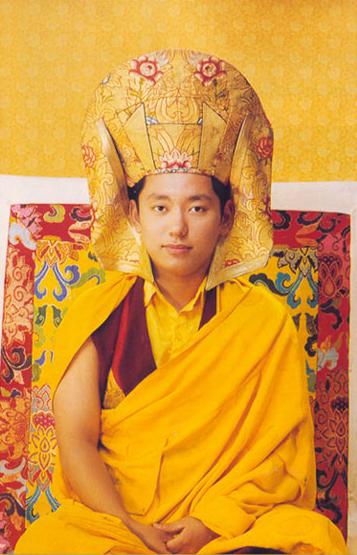

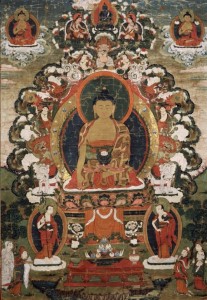
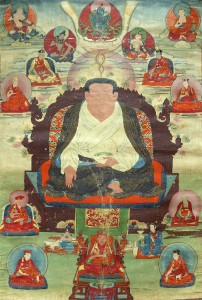
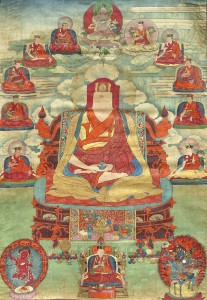
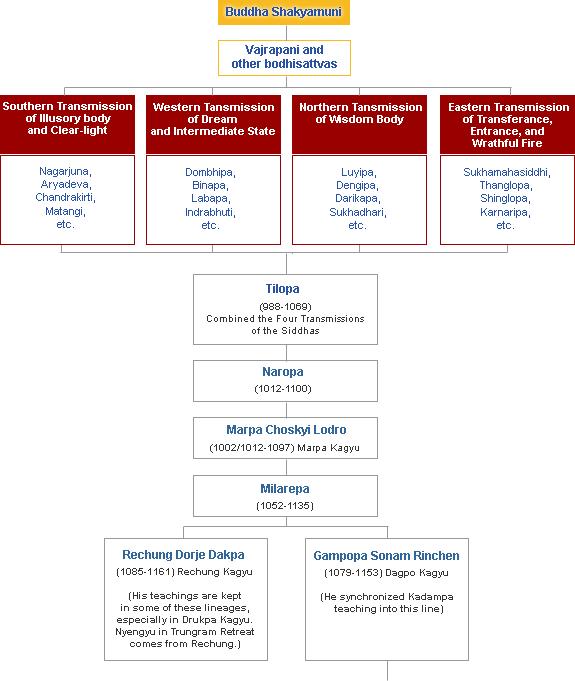
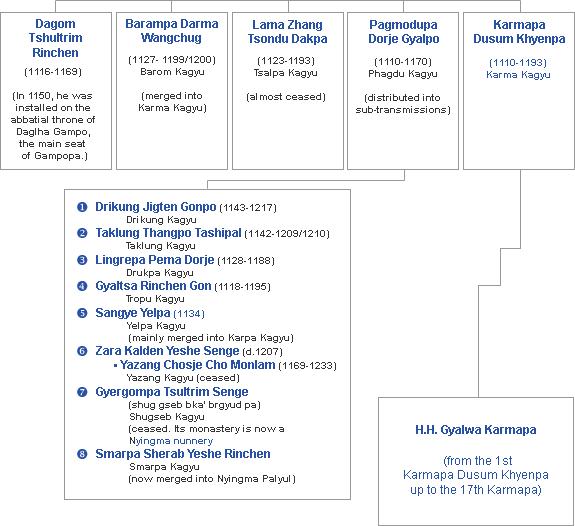
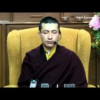

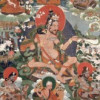
 Follow
Follow